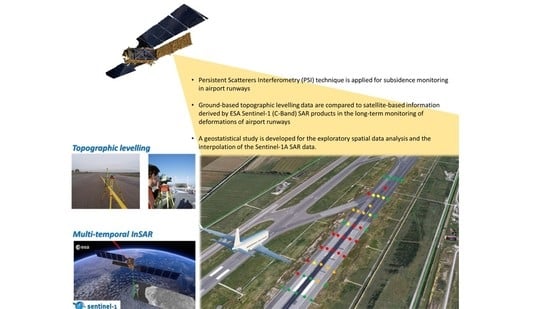Testing Sentinel-1 SAR Interferometry Data for Airport Runway Monitoring: A Geostatistical Analysis
Abstract
1. Introduction
2. Displacement Monitoring Techniques and Data-Analysis Methods for Airport Infrastructure Management: Background and Open Issues
2.1. Topographic Levelling
2.2. Multi-Temporal SAR Interferometry (MT-InSAR)
MT-InSAR for Airport Infrastructure Monitoring: An Overview of Applications and Areas of Further Research
- The comparison between measurements from satellite databases (medium and high resolutions) and ground-truth measurements from topographic levelling directly collected on an airport runway;
- Analysing a medium resolution dataset (Sentinel 1, C-Band) for the monitoring of displacements in an airport runway affected by well-known deformations, including a long-term investigation for the suitability of the Sentinel-1 sensor to detect displacements in the area of subsidence;
- The dataset peculiarities: the runway is constructed on a flat area, hence, due to the high construction standard requirements [60], this can be assumed as a horizontal structure with limited and evenly-distributed settlements. In this paper, the effectiveness of the C-Band medium resolution is tested against a scenario where settlements have formed relatively rapidly in time and are localised in certain sections.
2.3. Data-Analysis Methods: An Overview on Geostatistical Approaches and Areas of Further Research
- The detection of local and global outliers; the detection of potential non-stationarity in spatial variability (e.g., the presence of a trend);
- An assessment of the necessity to transform the data due to highly skewed distributions (e.g., by means of log and box-cox transformations);
- The detection of spatial continuity anisotropy.
- To investigate into their spatial variability across the runway, which is affected by displacements of different scale (size and spatial distribution);
- To optimise the fitting model for interpolation purposes;
- To explore the variability characteristics of the satellite data (medium and high resolution).
3. Aim and Objectives
- To measure and evaluate the suitability of Sentinel 1 (C-Band) SAR data for monitoring airport runway pavements displacements on a multi-year temporal scale through the satellite-based PSI monitoring technique;
- To compare the results obtained by the PSI technique to the measurements collected via a dense topographic levelling campaign, through a geostatistical analysis;
- To evaluate the feasibility of the proposed geostatistical analysis as a reliable investigation approach for the comparison of satellite-based and ground-based displacement information, as well as a tool for the integration of satellite-based information within next generation APMS to improve upon current maintenance strategies.
4. Methodology
4.1. Implemented Displacement Monitoring Techniques and Data Exploration Approach
4.1.1. Topographic Levelling: Data Acquisition Methods
4.1.2. PSI Data Processing
- Creation of the “Connection Graphs” where a Master image is selected to allow the identification of the connections for the formation of the interferograms. Then, a statistical analysis of the amplitudes of the electromagnetic response is performed on a pixel-by-pixel basis to compute the Amplitude Dispersion Index. The reference master image was selected amongst those acquired in the middle of the temporal and perpendicular baseline domain, to minimise space and temporal decorrelations. Therefore, the corresponding interferograms for each pair of master-slave images are computed.
- The second step is based on the identification of the Persistent Scatterer Candidates (PSCs), selected by computing the amplitude dispersion index values relative to each pixel. The PSCs are pixels, associated to the resolution cell of the SAR sensor, with a value of stability index exceeding a fixed threshold (typically of 0.25). The interferometric phase Δϕi is computed for any PSC, at any ith interferogram.
- The atmospheric phase contributions (ϕatm) as well as, the orbital and noise-related effects (ϕnoise) are evaluated and removed from the interferometric phase (Δϕi), to identify the phase-shift uniquely related to the range variations. To elaborate, the topographic phase (ϕtopo) is removed using the Digital Elevation Model (DEM) acquired in the framework of the Shuttle Radar Topographic Mission (SRTM), with a pixel resolution of 3 arc seconds (90 × 90 m). This is made available by the National Aeronautics and Space Administration (NASA) in partnership with the United States Geological Survey (USGS). The DEM resolution is adopted considering that the area investigated for the airport runway is flat, and the phase values are slightly affected by this parameter.
4.2. Geostatistical Analysis
- ESDA: analysis of the spatial sampling geometry, statistical summaries, spatial explorative analysis and analysis of the spatial continuity by means of experimental variograms, with identification of the main directions of the anisotropy.
- Inference of a variogram model: fitting of the experimental variogram with a variogram model, considering the main directions of the anisotropy.
- Interpolation and accuracy assessment: data interpolation using the fitted variogram model and the appropriate kriging algorithm, considering the spatial statistical structure of the data.
5. Case Study
5.1. Area of Investigation
5.2. Displacement Monitoring Techniques: Equipment and Datasets
5.2.1. Satellite SAR Datasets
5.2.2. Topographic Levelling Equipment
6. Results and Discussion
6.1. Displacement Monitoring Techniques: Persistent Scatterers Interferometry (PSI) and Topographic Levelling Investigations
6.2. The Geostatistical Analysis
7. Conclusions and Future Developments
- The Sentinel1 (C-Band) SAR datasets, processed by means of the PSI technique, allow detecting airport runway displacements and quantify their velocity of motion (mm/yr) with high accuracy and correlation levels (e.g., correlation coefficient (r = 0.94)), compared to established on-site topographic levelling data.
- The proposed geostatistical analysis based on the Ordinary Kriging (OK) approach can be successfully implemented to compare results achieved by the application of the PSI technique to medium-resolution Sentinel-1 data with the measurements collected using the ground-based topographic levelling method. This is proven by the high values of the multiple R-squared coefficient (R2 = 0.88) and a Slope of 0.96.
- The presented geostatistical analysis has proven effective in comparing satellite-based and ground-based displacement information for airport runway monitoring. The relatively dense information gathered through the InSAR technique as well as the controlled conditions and the strict compliance to high standards of pavement quality and the operations in airport traffic management lends itself to be incorporated in specialist geostatistical investigations of millimetre-scale structural displacements. The information can be crucial for inclusion in next generation Airport Pavement Management Systems (APMSs).
Author Contributions
Funding
Acknowledgments
Conflicts of Interest
References
- Chang, P.C.; Flatau, A.; Liu, S.C. Review Paper: Health Monitoring of Civil Infrastructure. Struct. Health Monit. 2003, 2, 257–267. [Google Scholar] [CrossRef]
- Nourzad, S.H.H.; Pradhan, A. Vulnerability of Infrastructure Systems: Macroscopic Analysis of Critical Disruptions on Road Networks. J. Infrastruct. Syst. 2016, 22, 04015014. [Google Scholar] [CrossRef]
- Italian Ministry of Infrastructure and Transport. Guideilines for the Classification and Management of the Risk, the Evaluation of the Safety and the Monitoring of the Existing Bridges. 2020. Available online: www.mit.gov.it/sites/default/files/media/notizia/2020-05/1_Testo_Linee_Guida_ponti.pdf (accessed on 21 September 2020).
- Cavalagli, N.; Kita, A.; Falco, S.; Trillo, F.; Costantini, M.; Ubertini, F. Satellite radar interferometry and in-situ measurements for static monitoring of historical monuments: The case of Gubbio, Italy. Remote. Sens. Environ. 2019, 235, 111453. [Google Scholar] [CrossRef]
- Meng, X.; Dodson, A.H.; Roberts, G.W. Detecting bridge dynamics with GPS and triaxial accelerometers. Eng. Struct. 2007, 29, 3178–3184. [Google Scholar] [CrossRef]
- Chen, K.; Lu, M.; Fan, X.; Wei, M.; Wu, J. Road condition monitoring using on-board Three-axis Accelerometer and GPS Sensor. In Proceedings of the 2011 6th International ICST Conference on Communications and Networking in China (CHINACOM), Harbin, China, 17–19 August 2011; pp. 1032–1037. [Google Scholar]
- Olund, J.; DeWolf, J. Passive Structural Health Monitoring of Connecticut’s Bridge Infrastructure. J. Infrastruct. Syst. 2007, 13, 330–339. [Google Scholar] [CrossRef]
- Chae, M.J.; Yoo, H.S.; Kim, J.Y.; Cho, M.Y. Development of a wireless sensor network system for suspension bridge health monitoring. Autom. Constr. 2012, 21, 237–252. [Google Scholar] [CrossRef]
- Barbarella, M.; Di Benedetto, A.; Fiani, M.; Guida, D.; Lugli, A. Use of DEMs Derived from TLS and HRSI Data for Landslide Feature Recognition. ISPRS Int. J. Geo-Inf. 2018, 7, 160. [Google Scholar] [CrossRef]
- Riveiro, B.; Morer, P.; Arias, P.; de Arteaga, I. Terrestrial laser scanning and limit analysis of masonry arch bridges. Constr. Build. Mater. 2011, 25, 1726–1735. [Google Scholar] [CrossRef]
- Sato, H.P.; Abe, K.; Ootaki, O. GPS-measured land subsidence in Ojiya City, Niigata Prefecture, Japan. Eng. Geol. 2003, 67, 379–390. [Google Scholar] [CrossRef]
- Alani, A.M.; Aboutalebi, M.; Kilic, G. Applications of ground penetrating radar (GPR) in bridge deck monitoring and assessment. J. Appl. Geophys. 2013, 97, 45–54. [Google Scholar] [CrossRef]
- Alani, A.M.; Aboutalebi, M.; Kilic, G. Integrated health assessment strategy using NDT for reinforced concrete bridges. NDT E Int. 2014, 61, 80–94. [Google Scholar] [CrossRef]
- Benedetto, A.; Tosti, F.; Ciampoli, L.B.; D’Amico, F. An overview of ground-penetrating radar signal processing techniques for road inspections. Signal Process. 2017, 132, 201–209. [Google Scholar] [CrossRef]
- Ciampoli, L.B.; Artagan, S.S.; Tosti, F.; Gagliardi, V.; Alani, A.; Benedetto, A. A comparative investigation of the effects of concrete sleepers on the GPR signal for the assessment of railway ballast. In Proceedings of the 17th International Conference on Ground Penetrating Radar (GPR), Rapperswil, Switzerland, 18–21 June 2018; pp. 1–4. [Google Scholar] [CrossRef]
- Solla, M.; Pérez-Gracia, V.; Fontul, S. A Review of GPR Application on Transport Infrastructures: Troubleshooting and Best Practices. Remote Sens. 2021, 13, 672. [Google Scholar] [CrossRef]
- Solla, M.; Lorenzo, H.; Rial, F.; Novo, A. Ground-penetrating radar for the structural evaluation of masonry bridges: Results and interpretational tools. Constr. Build. Mater. 2012, 29, 458–465. [Google Scholar] [CrossRef]
- Mossop, A.; Segall, P. Subsidence at The Geysers Geothermal Field, N. California from a comparison of GPS and leveling surveys. Geophys. Res. Lett. 1997, 24, 1839–1842. [Google Scholar] [CrossRef]
- Stabile, T.A.; Perrone, A.; Gallipoli, M.; Ditommaso, R.; Ponzo, F.C. Dynamic Survey of the Musmeci Bridge by Joint Application of Ground-Based Microwave Radar Interferometry and Ambient Noise Standard Spectral Ratio Techniques. IEEE Geosci. Remote Sens. Lett. 2013, 10, 870–874. [Google Scholar] [CrossRef]
- Tosti, F.; Alani, A.M.; Benedetto, A.; Loizos, A.; Soldovieri, F. Guest Editorial: Recent Advances in Non-destructive Testing Methods. Surv. Geophys. 2020, 41, 365–369. [Google Scholar] [CrossRef]
- Tosti, F.; Benedetto, A.; Ciampoli, L.B.; D’Amico, F.; Plati, C.; Loizos, A. Guest Editorial: Data Fusion, integration and advances of non-destructive testing methods in civil and environmental engineering. NDT E Int. 2020, 115, 102286. [Google Scholar] [CrossRef]
- Solla, M.; Lagüela, S.; Fernández, N.; Garrido, I. Assessing Rebar Corrosion through the Combination of Nondestructive GPR and IRT Methodologies. Remote Sens. 2019, 11, 1705. [Google Scholar] [CrossRef]
- Lagüela, S.; Solla, M.; Puente, I.; Prego, F.J. Joint use of GPR, IRT and TLS techniques for the integral damage detection in paving. Constr. Build. Mater. 2018, 174, 749–760. [Google Scholar] [CrossRef]
- Alani, A.M.; Tosti, F.; Bianchini Ciampoli, L.; Gagliardi, V.; Benedetto, A. An integrated investigative approach in health monitoring of masonry arch bridges using GPR and InSAR technologies. NDT E Int. 2020, 115, 102288. [Google Scholar] [CrossRef]
- Bianchini Ciampoli, L.; Gagliardi, V.; Clementini, C.; Latini, D.; Del Frate, F.; Benedetto, A. Transport Infrastructure Monitoring by InSAR and GPR Data Fusion. Surv. Geophys. 2020, 41, 371–394. [Google Scholar] [CrossRef]
- Colesanti, C.; Ferretti, A.; Prati, C.; Rocca, F. Monitoring landslides and tectonic motions with the Permanent Scatterers Technique. Eng. Geol. 2003, 68, 3–14. [Google Scholar] [CrossRef]
- Ferretti, A.; Fumagalli, A.; Novali, F.; Prati, C.; Rocca, F.; Rucci, A. A new algorithm for processing interferometric data-stacks: SqueeSARTM. IEEE Trans. Geosci. Remote Sens. 2011, 49, 3460–3470. [Google Scholar] [CrossRef]
- Ferretti, A.; Prati, C.; Rocca, F. Nonlinear subsidence rate estimation using permanent scatterers in differential SAR interferometry. IEEE Trans. Geosci. Remote Sens. 2000, 38, 2202–2212. [Google Scholar] [CrossRef]
- Ferretti, A.; Prati, C.; Rocca, F. Permanent scatterers in SAR interferometry. IEEE Trans. Geosci. Remote Sens. 2001, 39, 8–20. [Google Scholar] [CrossRef]
- Lanari, R.; Mora, O.; Manunta, M.; Mallorqui, J.J.; Berardino, P.; Sansosti, E. A small-baseline approach for investigating deformations on full-resolution differential SAR interferograms. IEEE Trans. Geosci. Remote Sens. 2004, 42, 1377–1386. [Google Scholar] [CrossRef]
- Bianchini Ciampoli, L.; Gagliardi, V.; Ferrante, C.; Calvi, A.; D’Amico, F.; Tosti, F. Displacement Monitoring in Airport Runways by Persistent Scatterers SAR Interferometry. Remote Sens. 2020, 12, 3564. [Google Scholar] [CrossRef]
- Elhassan, I.M.; Ali, A. Comparative study of accuracy in distance measurement using: Optical and digital levels. J. King Saud Univ. Eng. Sci. 2011, 23, 15–19. [Google Scholar] [CrossRef]
- Cosser, E.; Roberts, G.W.; Meng, X.; Dodson, A.H. Measuring the Dynamic Deformation of Bridges Using a Total Station. In Proceedings of the 11th FIG Symposium on Deformation Measurements, Santorini, Greece, 25–28 May 2003. [Google Scholar]
- Berardino, P.; Fornaro, G.; Lanari, R.; Sansosti, E. A new algorithm for surface deformation monitoring based on small baseline differential SAR interferograms. IEEE Trans. Geosci. Remote Sens. 2002, 40, 2375–2383. [Google Scholar] [CrossRef]
- Tosti, F.; Gagliardi, V.; D’Amico, F.; Alani, A.M. Transport infrastructure monitoring by data fusion of GPR and SAR imagery information. Transp. Res. Procedia 2020, 45, 771–778. [Google Scholar] [CrossRef]
- Chang, L.; Dollevoet, R.P.B.J.; Hanssen, R. Nationwide Railway Monitoring Using Satellite SAR Interferometry. IEEE J. Sel. Top. Appl. Earth Obs. Remote Sens. 2017, 10, 596–604. [Google Scholar] [CrossRef]
- Yang, Z.; Schmid, F.; Roberts, C. Assessment of Railway Performance by Monitoring Land Subsidence. In Proceedings of the 6th IET Conference on Railway Condition Monitoring (RCM 2014), Birmingham, UK, 17–18 September 2014; pp. 1–6. [Google Scholar]
- D’Amico, F.; Gagliardi, V.; Bianchini Ciampoli, L.; Tosti, F. Integration of InSAR and GPR techniques for monitoring transition areas in railway bridges. NDT E Int. 2020, 115, 102291. [Google Scholar] [CrossRef]
- Ciampoli, L.B.; Gagliardi, V.; Calvi, A.; D’Amico, F.; Tosti, F. Automatic network level bridge monitoring by integration of InSAR and GIS catalogues. Multimodal Sens. Technol. Appl. 2019, 11059, 110590I. [Google Scholar] [CrossRef][Green Version]
- Gagliardi, V.; Benedetto, A.; Ciampoli, L.B.; D’Amico, F.; Alani, A.M.; Tosti, F. Health monitoring approach for transport infrastructure and bridges by satellite remote sensing Persistent Scatterers Interferometry (PSI). In Earth Resources and Environmental Remote Sensing/GIS Applications XI; SPIE: Washington, DC, USA, 2020; Volume 11534, p. 115340K. [Google Scholar] [CrossRef]
- Milillo, P.; Giardina, G.; DeJong, M.J.; Perissin, D.; Milillo, G. Multi-Temporal InSAR Structural Damage Assessment: The London Crossrail Case Study. Remote Sens. 2018, 10, 287. [Google Scholar] [CrossRef]
- Gagliardi, V.; Ciampoli, L.B.; D’Amico, F.; Alani, A.M.; Tosti, F.; Battagliere, M.L.; Benedetto, A. Bridge monitoring and assessment by high-resolution satellite remote sensing technologies. In SPIE Future Sensing Technologies; SPIE: Washington, DC, USA, 2020; Volume 11525, p. 1152506. [Google Scholar] [CrossRef]
- Barla, G.; Tamburini, A.; Del Conte, S.; Giannico, C. InSAR monitoring of tunnel induced ground movements. Géoméch. Tunnelbau 2016, 9, 15–22. [Google Scholar] [CrossRef]
- Koudogbo, F.; Urdiroz, A.; Robles, J.G.; Chapron, G.; Lebon, G.; Fluteaux, V.; Priol, G. Radar interferometry as an inno-vative solution for monitoring the construction of the Grand Paris Express metro network—First results. In Proceedings of the World Tunnel Conference, Dubai, United Arab Emirates, 2–25 April 2018. [Google Scholar]
- Gagliardi, V.; Ciampoli, L.B.; D’Amico, F.; Alani, A.M.; Tosti, F.; Benedetto, A. Multi-Temporal SAR Interferometry for Structural Assessment of Bridges: The Rochester Bridge Case Study. In Airfield and Highway Pavements 2021; American Society of Civil Engineers: Reston, VA, USA, 2021; pp. 308–319. [Google Scholar] [CrossRef]
- Gao, M.; Gong, H.; Chen, B.; Zhou, C.; Chen, W.; Liang, Y.; Shi, M.; Si, Y. InSAR time-series investigation of long-term ground displacement at Beijing Capital International Airport, China. Tectonophysics 2016, 691, 271–281. [Google Scholar] [CrossRef]
- Jiang, L.; Lin, H. Integrated analysis of SAR interferometric and geological data for investigating long-term reclamation settlement of Chek Lap Kok Airport, Hong Kong. Eng. Geol. 2010, 110, 77–92. [Google Scholar] [CrossRef]
- Gagliardi, V.; Bianchini Ciampoli, L.; D’Amico, F.; Alani, A.M.; Tosti, F.; Battagliere, M.L.; Benedetto, A. Novel perspectives in the monitoring of transport infrastructures by Sentinel-1 and COSMO-SkyMed Multi-Temporal SAR Interferometry. In Proceedings of the 2021 International Geoscience and Remote Sensing Symposium, IGARSS, Brussels, Belgium, 12–16 July 2021. [Google Scholar]
- Fuhrmann, T.; Garthwaite, M.C. Resolving Three-Dimensional Surface Motion with InSAR: Constraints from Multi-Geometry Data Fusion. Remote Sens. 2019, 11, 241. [Google Scholar] [CrossRef]
- Gagliardi, V.; Ciampoli, L.B.; D’Amico, F.; Tosti, F.; Alani, A.M.; Benedetto, A. A novel geo-statistical approach for transport infrastructure network monitoring by Persistent Scatterer Interferometry (PSI). In Proceedings of the 2020 IEEE Radar Conference (RadarConf20), Florence, Italy, 21–25 September 2020; pp. 1–6. [Google Scholar]
- Jiang, Y.; Liao, M.; Wang, H.; Zhang, L.; Balz, T. Deformation Monitoring and Analysis of the Geological Environment of Pudong International Airport with Persistent Scatterer SAR Interferometry. Remote Sens. 2016, 8, 1021. [Google Scholar] [CrossRef]
- Wu, S.; Yang, Z.; Ding, X.; Zhang, B.; Zhang, L.; Lu, Z. Two decades of settlement of Hong Kong International Airport measured with multi-temporal InSAR. Remote Sens. Environ. 2020, 248, 111976. [Google Scholar] [CrossRef]
- Liu, X.; Zhao, C.; Zhang, Q.; Yang, C.; Zhang, J. Characterizing and Monitoring Ground Settlement of Marine Reclamation Land of Xiamen New Airport, China with Sentinel-1 SAR Datasets. Remote Sens. 2019, 11, 585. [Google Scholar] [CrossRef]
- Gao, M.; Gong, H.; Li, X.; Chen, B.; Zhou, C.; Shi, M.; Guo, L.; Chen, Z.; Ni, Z.; Duan, G. Land Subsidence and Ground Fissures in Beijing Capital International Airport (BCIA): Evidence from Quasi-PS InSAR Analysis. Remote Sens. 2019, 11, 1466. [Google Scholar] [CrossRef]
- Karimzadeh, S.; Matsuoka, M. Remote Sensing X-Band SAR Data for Land Subsidence and Pavement Monitoring. Sensors 2020, 20, 4751. [Google Scholar] [CrossRef]
- Even, M.; Schulz, K. InSAR Deformation Analysis with Distributed Scatterers: A Review Complemented by New Advances. Remote Sens. 2018, 10, 744. [Google Scholar] [CrossRef]
- Shamshiri, R.; Nahavandchi, H.; Motagh, M.; Hooper, A. Efficient Ground Surface Displacement Monitoring Using Sentinel-1 Data: Integrating Distributed Scatterers (DS) Identified Using Two-Sample t-Test with Persistent Scatterers (PS). Remote Sens. 2018, 10, 794. [Google Scholar] [CrossRef]
- Béjar-Pizarro, M.; Guardiola-Albert, C.; García-Cárdenas, R.P.; Herrera, G.; Barra, A.; Molina, A.L.; Tessitore, S.; Staller, A.; Ortega-Becerril, J.A.; García-García, R.P. Interpolation of GPS and Geological Data Using InSAR Deformation Maps: Method and Application to Land Subsidence in the Alto Guadalentín Aquifer (SE Spain). Remote Sens. 2016, 8, 965. [Google Scholar] [CrossRef]
- European Space Agency (ESA). Available online: https://sentinel.esa.int (accessed on 20 May 2021).
- Italian Civil Aviation Authority (ENAC). Regulations for the Construction and the Exercise of the Airports, 2nd ed.; ENAC: Rome, Italy, 2014. Available online: www.enac.gov.it/node/37485 (accessed on 10 July 2021).
- Goovaerts, P. Geostatistics for Natural Resources Evaluation; Oxford University Press: Oxford, UK, 1997. [Google Scholar]
- Isaaks, E.H.; Srivastava, R.M. An Introduction to Applied Geostatistics, 1st ed.; Oxford University Press: New York, NY, USA, 1989. [Google Scholar]
- Journel, A.G. Fundamentals of Geostatistics in Five Lessons; American Geophysical Union: Washington, DC, USA, 1989; Volume 8. [Google Scholar]
- Manson, S.M.; Burrough, P.A.; McDonnell, R.A. Principles of Geographical Information Systems: Spatial Information Systems and Geostatistics. Econ. Geogr. 1999, 75, 422–423. [Google Scholar] [CrossRef]
- Herzfeld, U.C. Inverse theory in the earth sciences—An introductory overview with emphasis on gandin’s method of optimum interpolation. Math. Geol. 1996, 28, 137–160. [Google Scholar] [CrossRef]
- Pebesma, E.J. Multivariable geostatistics in S: The gstat package. Comput. Geosci. 2004, 30, 683–691. [Google Scholar] [CrossRef]
- Atkinson, P.M.; Tate, N.J. Spatial Scale Problems and Geostatistical Solutions: A Review. Prof. Geogr. 2000, 52, 607–623. [Google Scholar] [CrossRef]
- SARscape Technical Description. 2012. Available online: http://www.sarmap.ch/pdf/SARscapeTechnical.pdf (accessed on 5 March 2020).
- Hengl, T.; Heuvelink, G.B.M.; Stein, A. A generic framework for spatial prediction of soil variables based on regression-kriging. Geoderma 2004, 120, 75–93. [Google Scholar] [CrossRef]
- Ploner, A. The use of the variogram cloud in geostatistical modelling. Environmetrics 1999, 10, 413–437. [Google Scholar] [CrossRef]
- R Core Team. R: A Language and Environment for Statistical Computing; R Foundation for Statistical Computing: Vienna, Austria, 2017; Available online: https://www.R-project.org (accessed on 20 June 2021).
- Italian Civil Aviation Authority (ENAC). Available online: https://www.enac.gov.it/aeroporti/infrastrutture-aeroportuali/master-plan (accessed on 20 May 2021).
- Manassero, M.; Dominijanni, A. Riqualifica Strutturale di un Sistema di Piste Aeroportuali Rivista Italiana di Geotecnica. 2010. Available online: https://associazionegeotecnica.it/wp-content/uploads/2014/01/rig_310_046.pdf (accessed on 23 August 2021).
- Global Registration Services. Available online: www.grs.it (accessed on 20 May 2021).
- Walter, C.; McBratney, A.B.; Douaoui, A.; Minasny, B. Spatial prediction of topsoil salinity in the Chelif Valley, Algeria, using local ordinary kriging with local variograms versus whole-area variogram. Soil Res. 2001, 39, 259. [Google Scholar] [CrossRef][Green Version]
- Benedetto, A.; D’Amico, F.; Tosti, F. Improving safety of runway overrun through the correct numerical evaluation of rutting in Cleared and Graded Areas. Saf. Sci. 2014, 62, 326–338. [Google Scholar] [CrossRef]


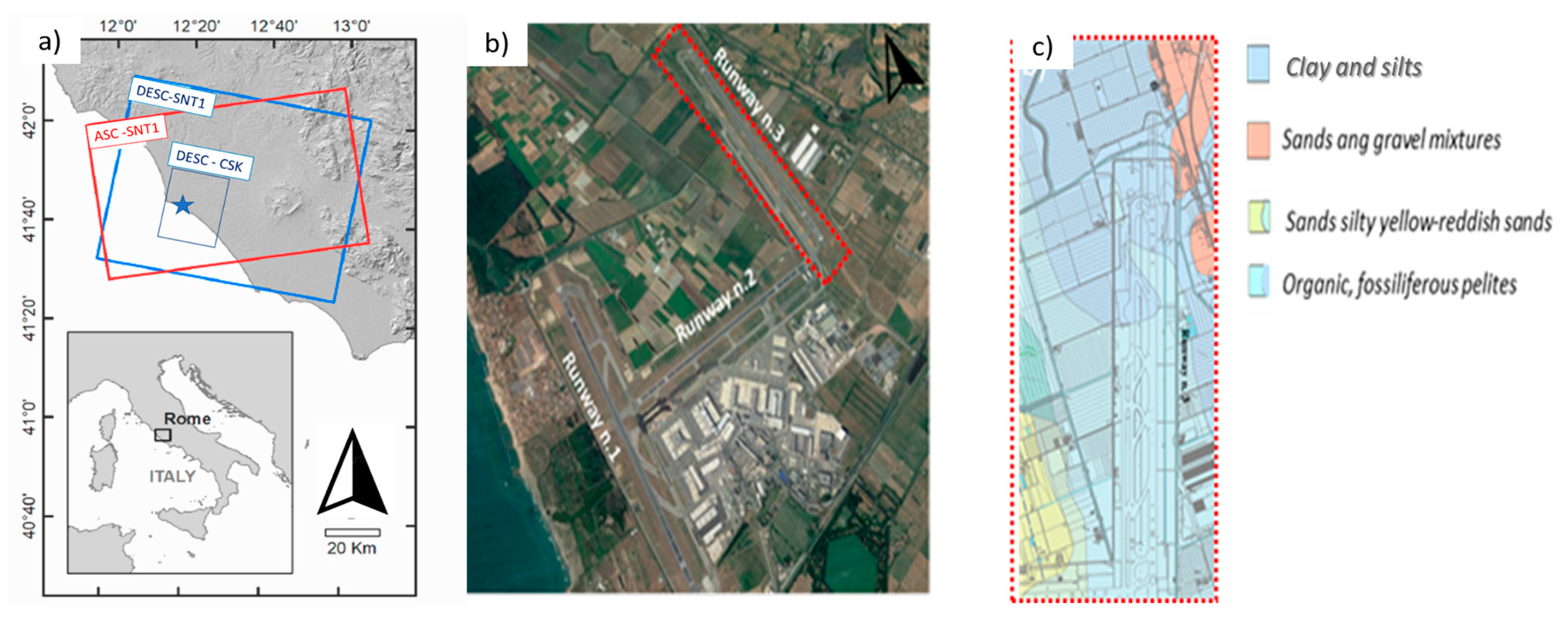
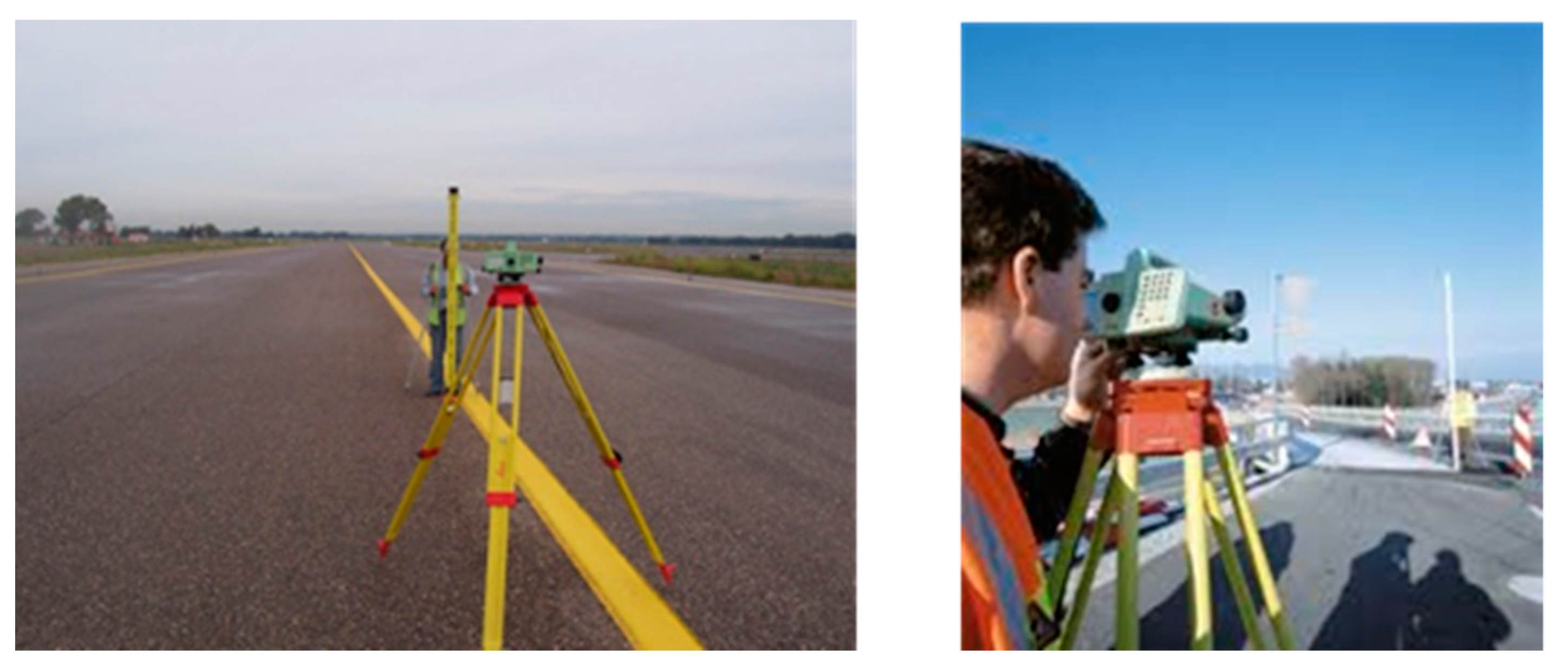
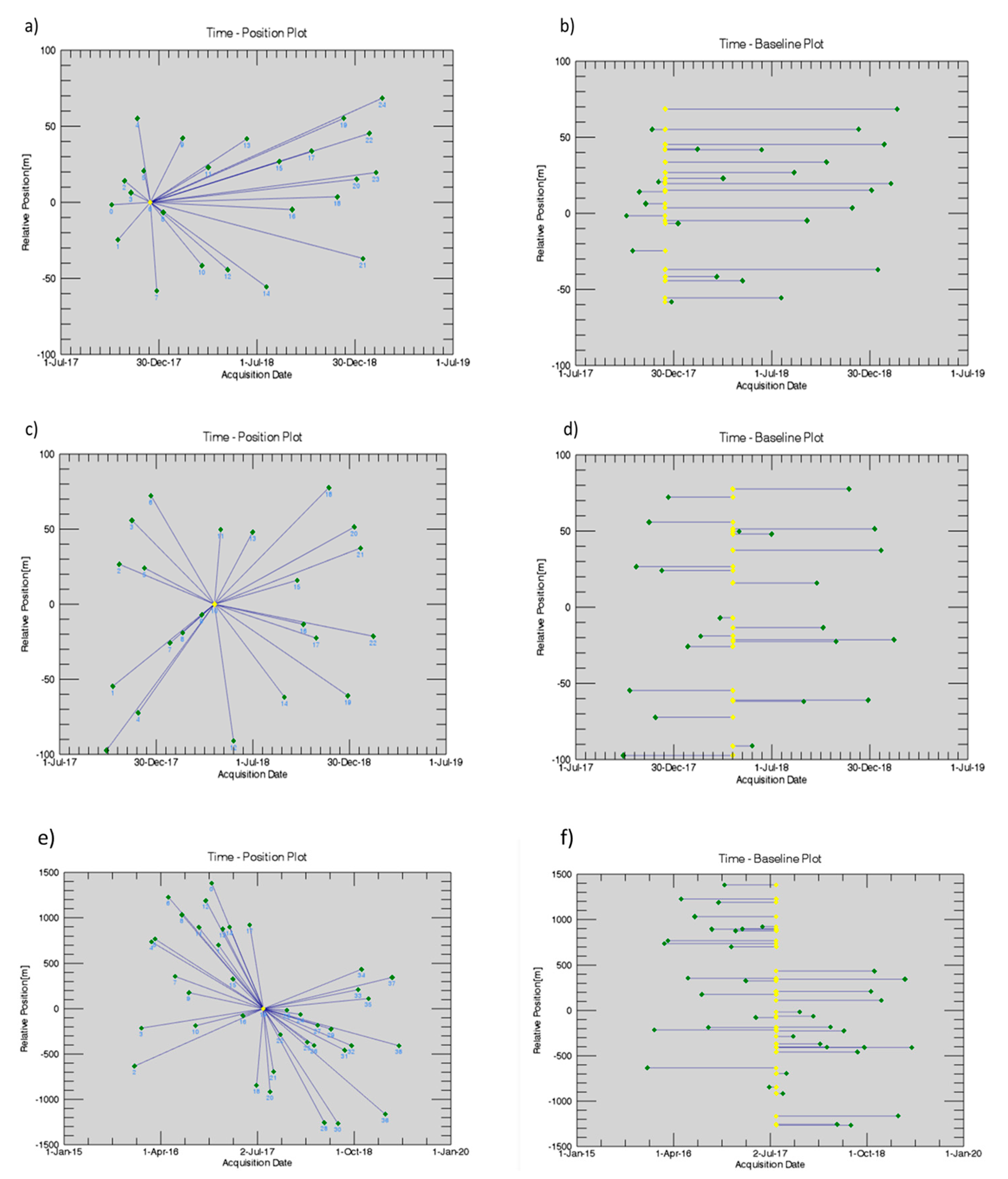
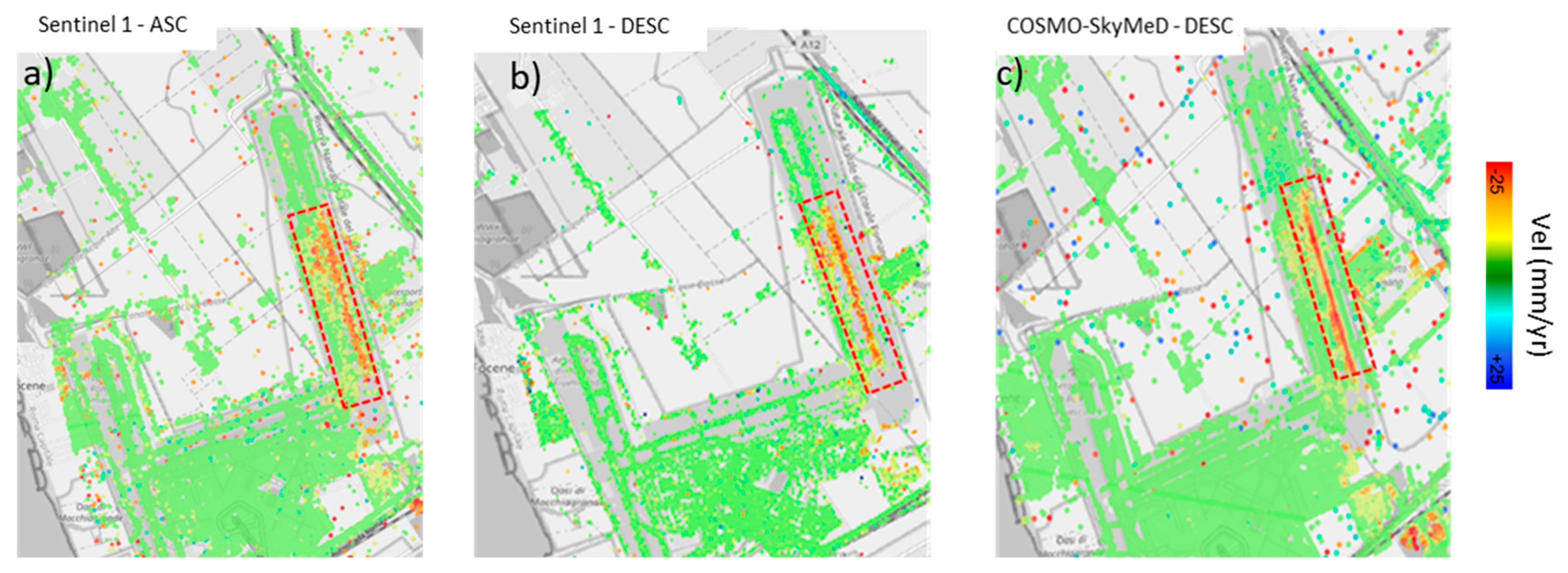
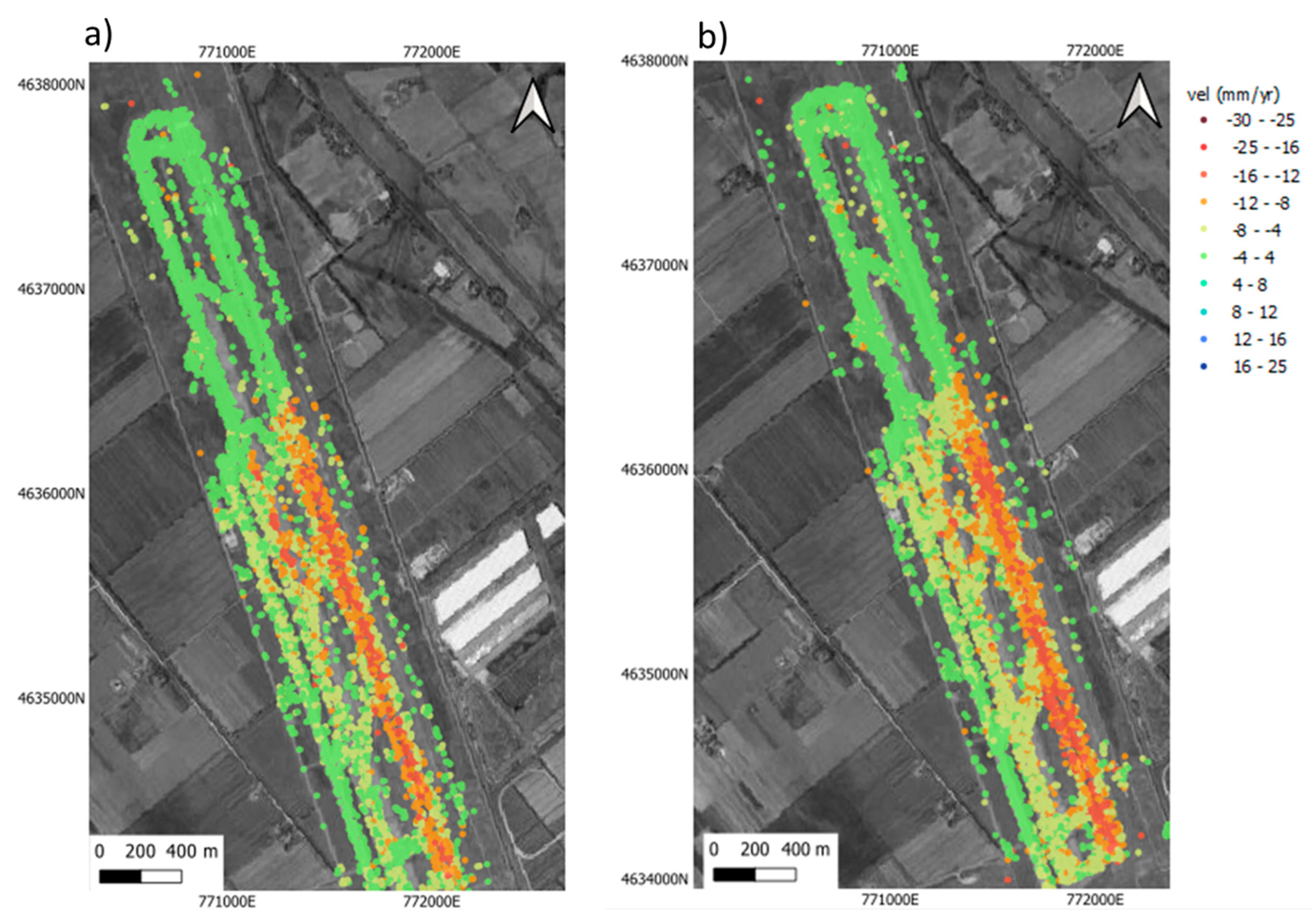
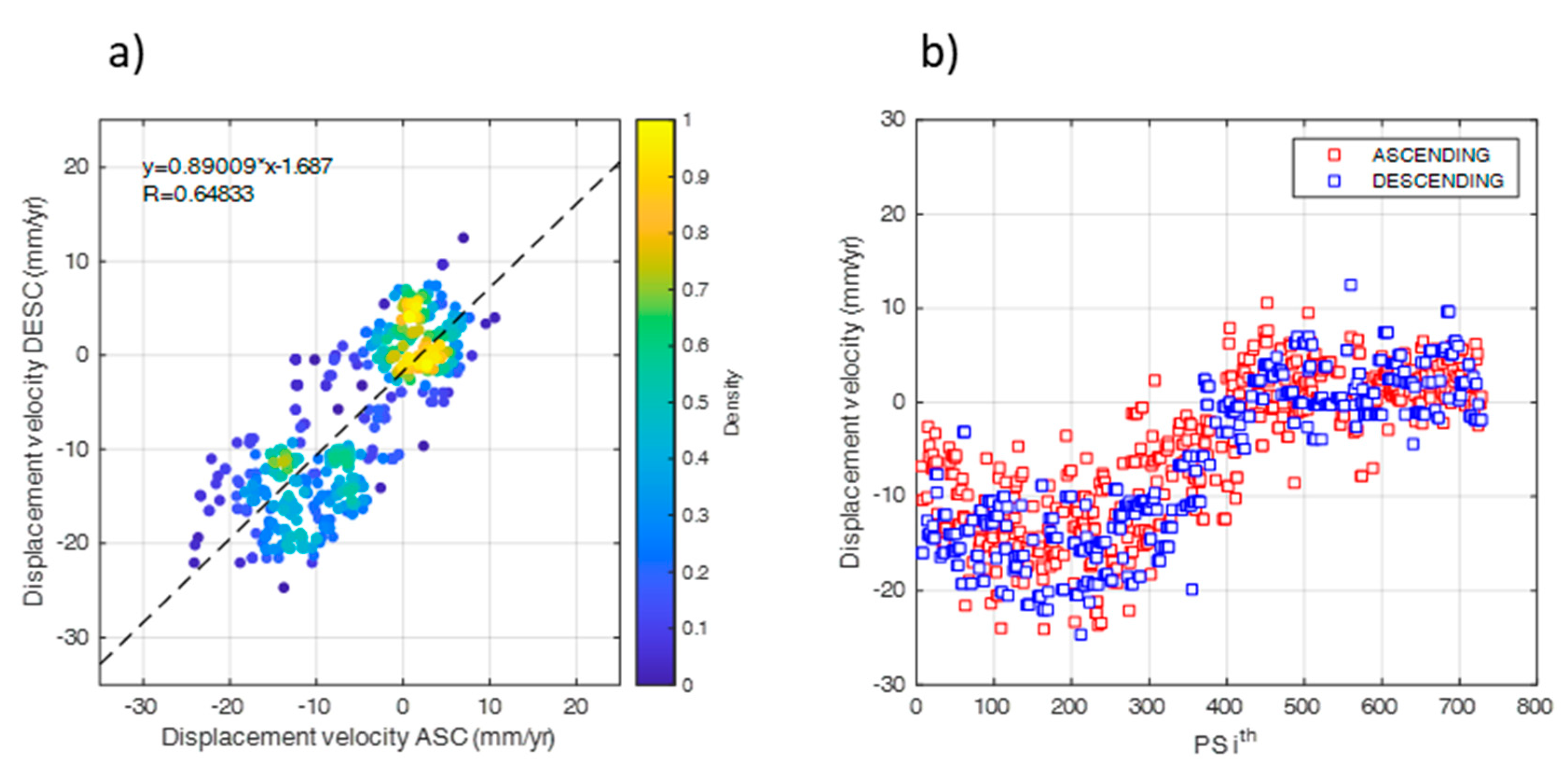
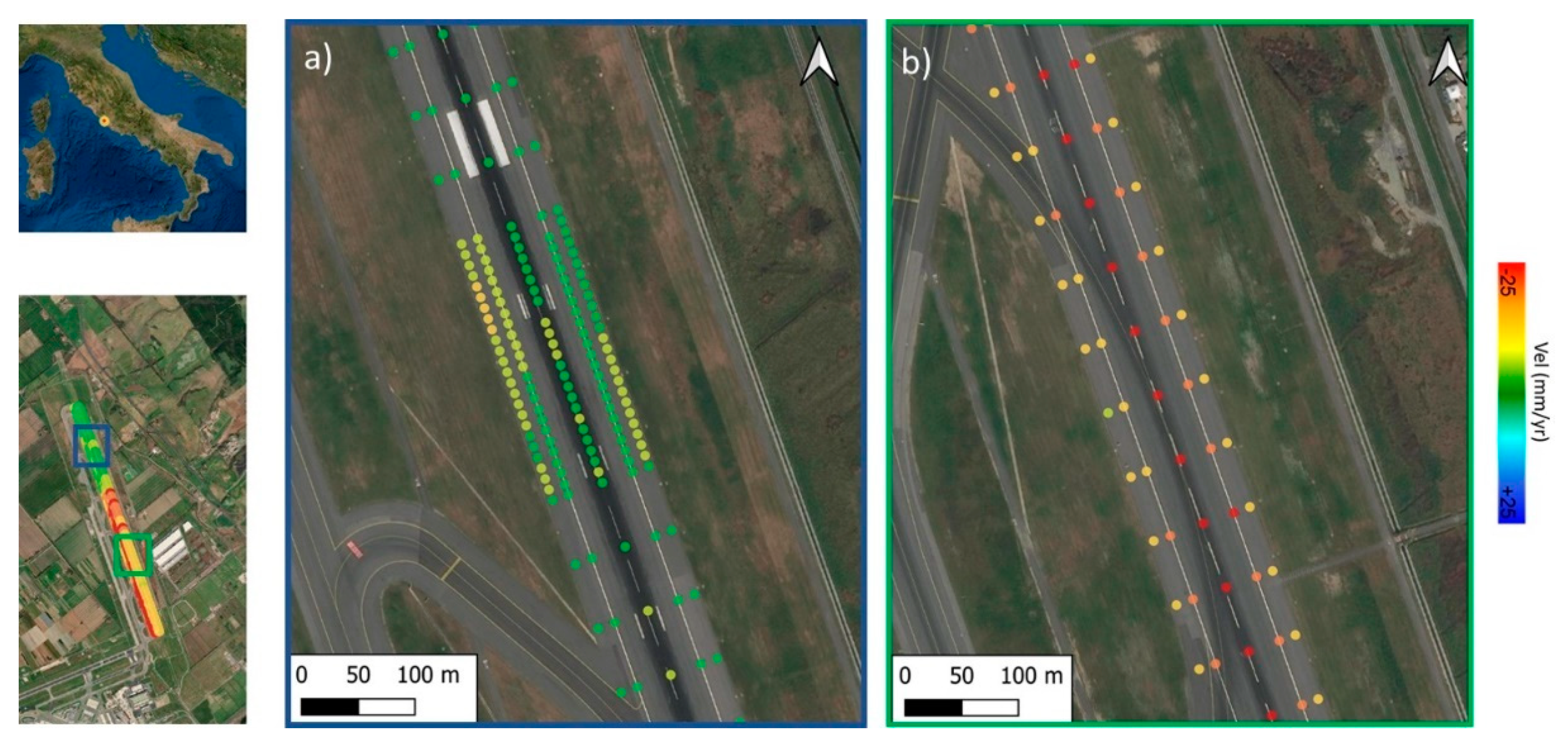
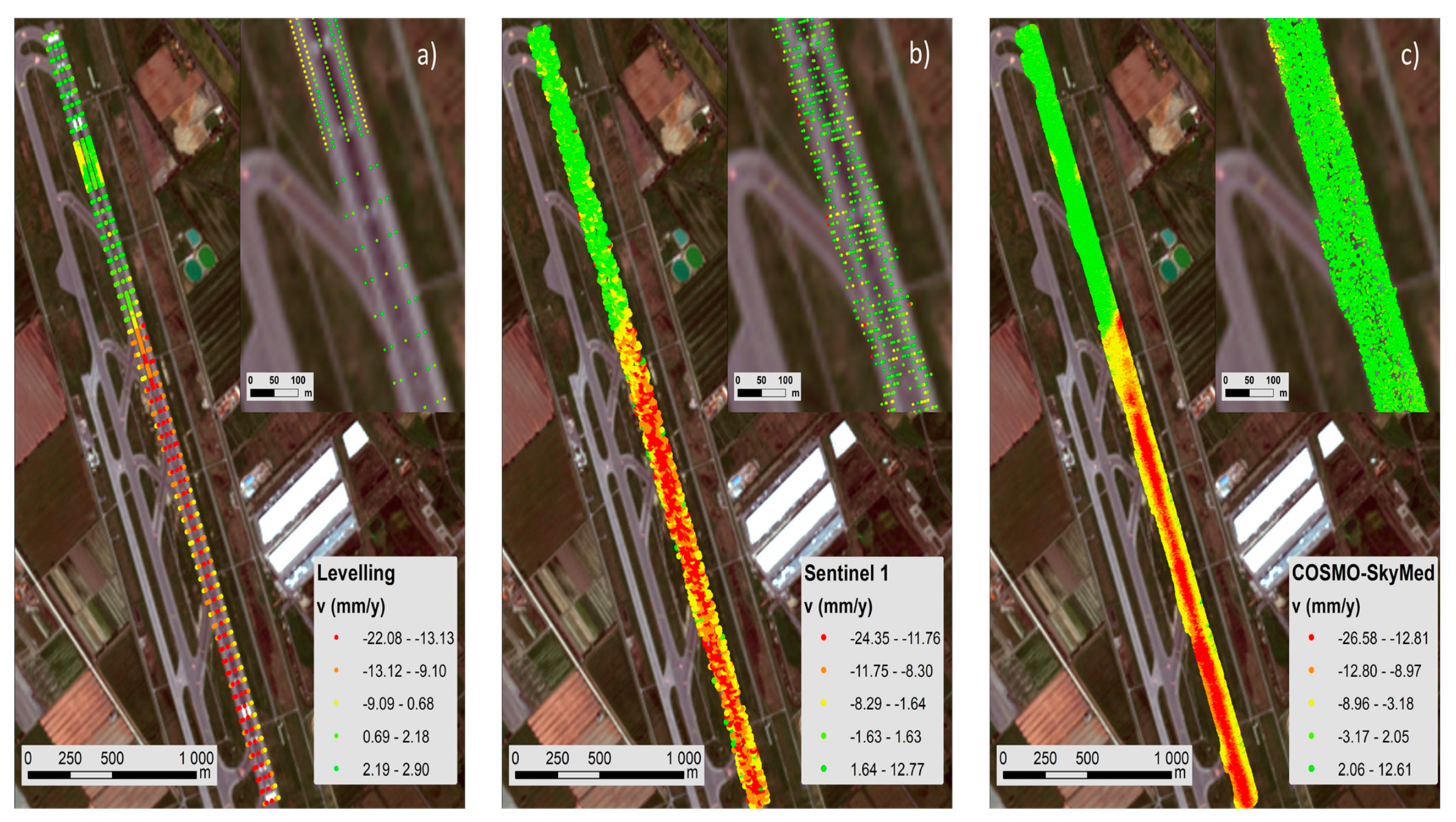

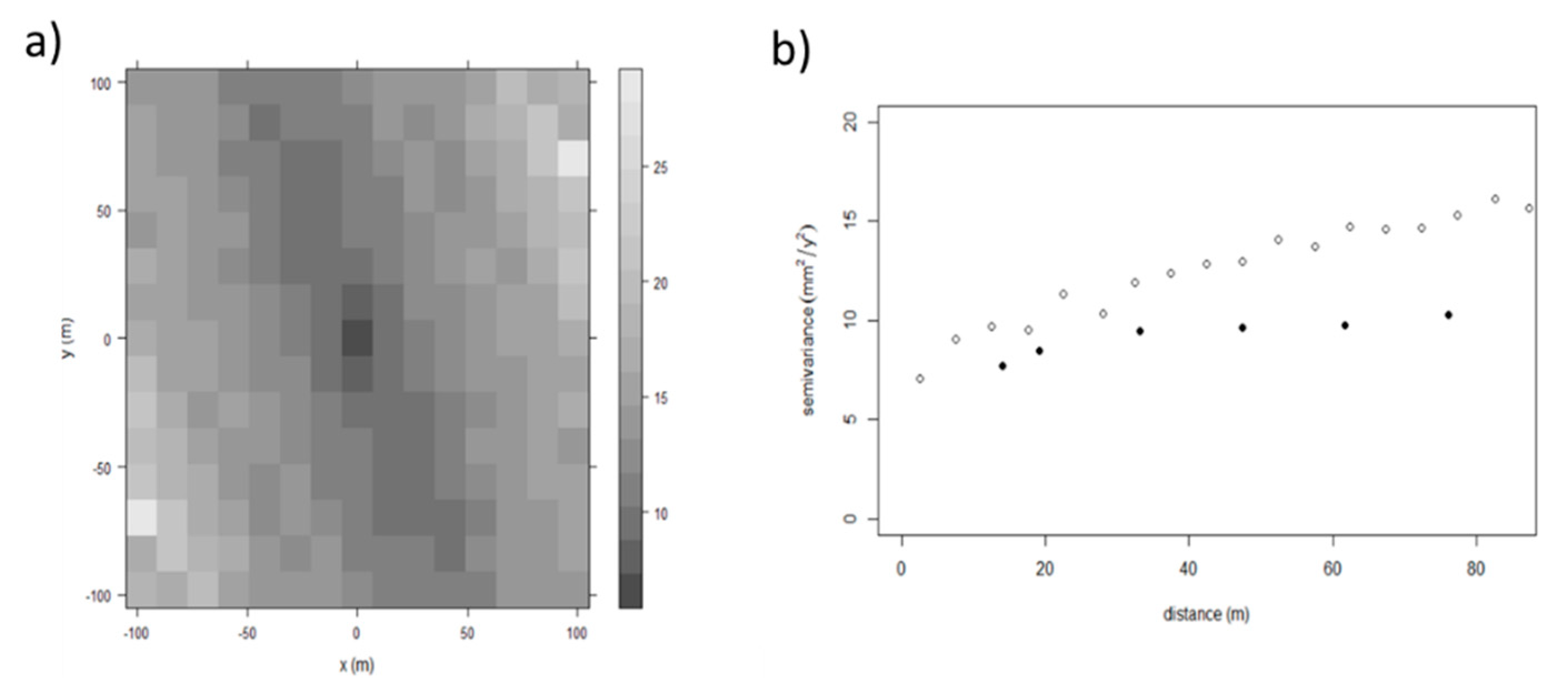
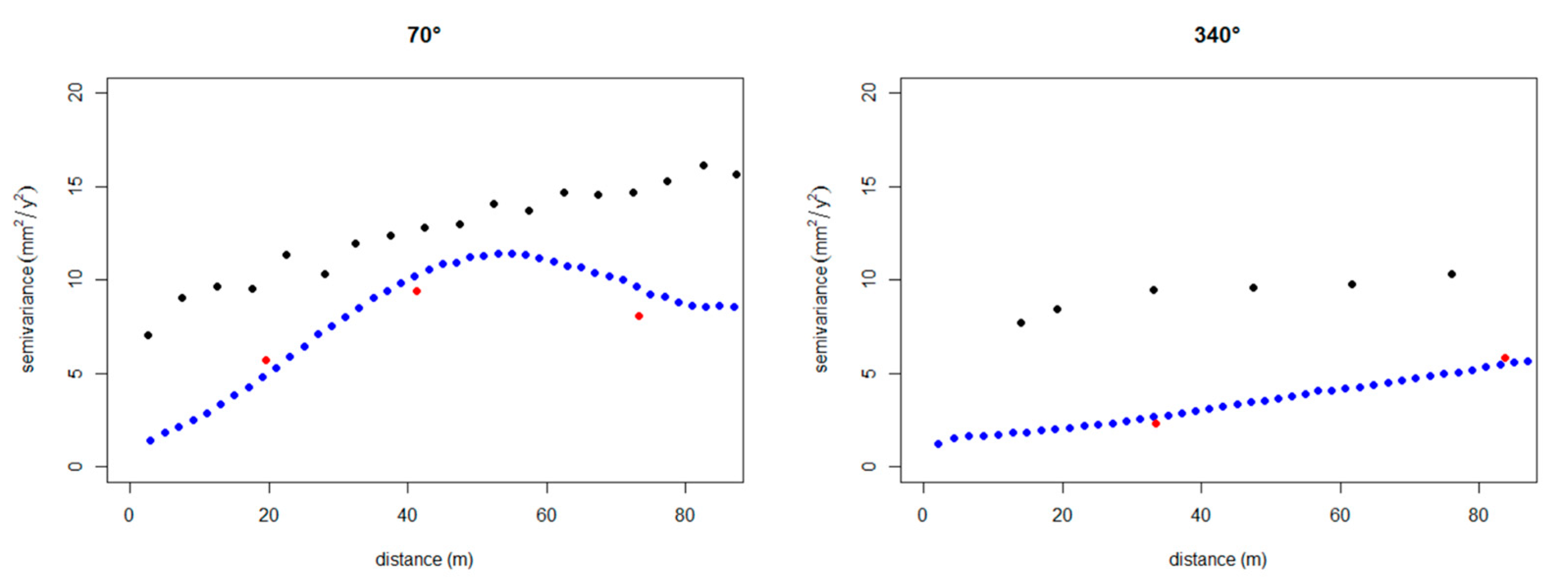
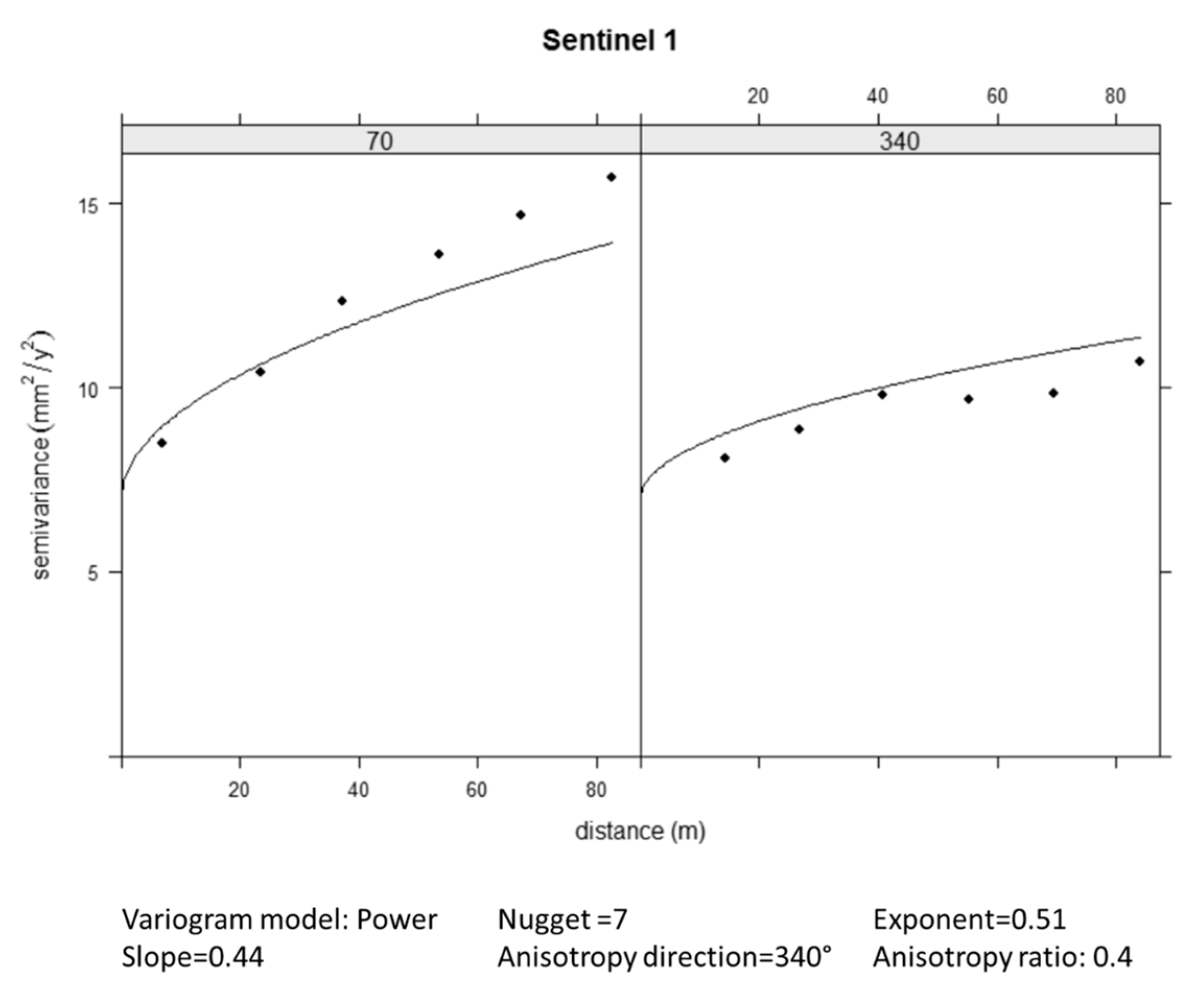

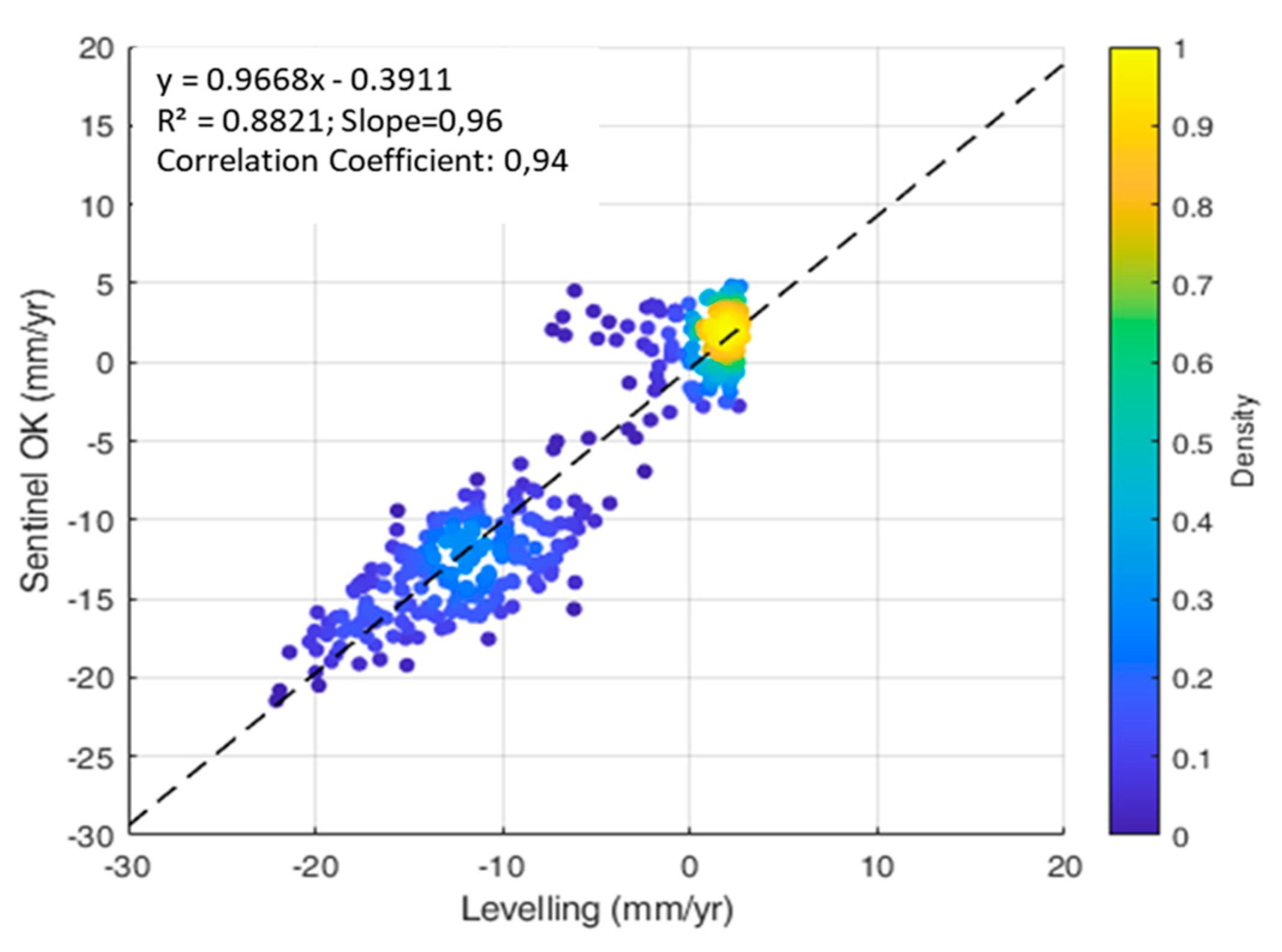
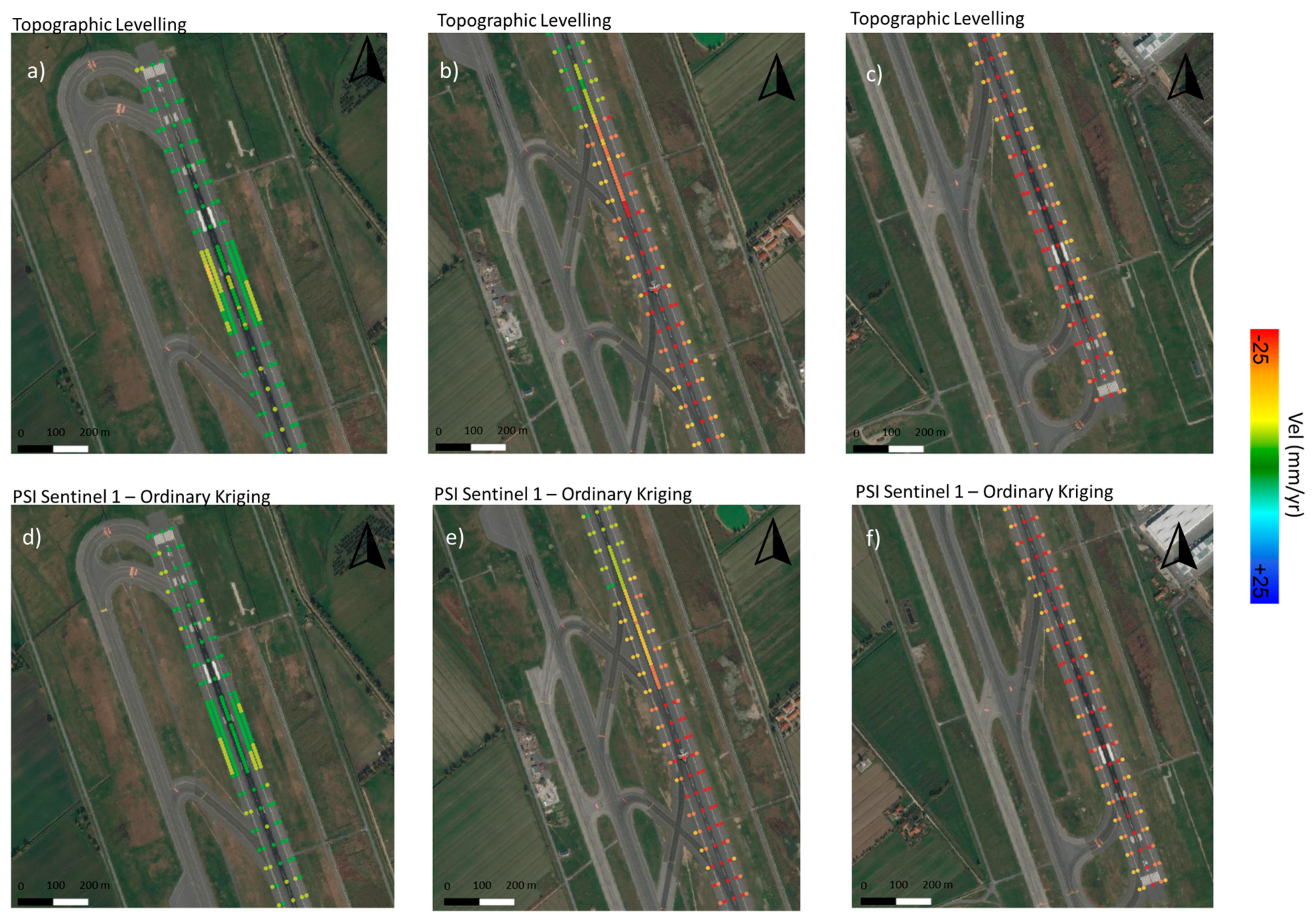
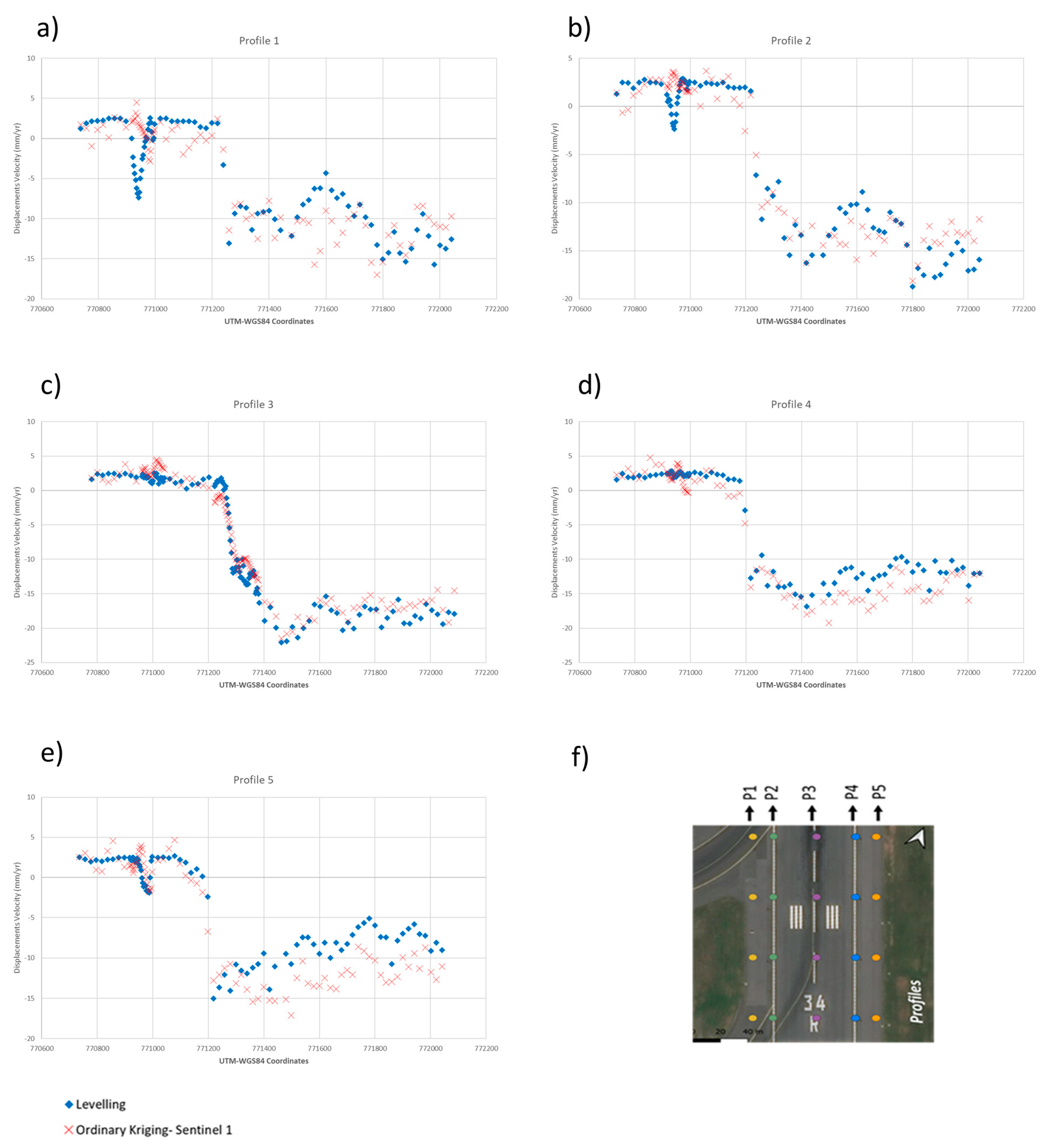
| NDT Technology | References |
|---|---|
| Accelerometers | [4,5,6] |
| Strain Gauges | [7] |
| Wireless Network Systems | [8] |
| Laser Scanner | [9,10] |
| Global Position System (GPS) | [11] |
| Ground Penetrating Radar (GPR) | [12,13,14,15,16,17] |
| Levelling data | [18] |
| Ground-based Interferometer | [19] |
| Satellite Missions | Sentinel 1A | COSMO-SkyMed |
|---|---|---|
| Band | C-Band | X-Band |
| Property | European Space Agency (ESA) | Italian Space Agency (ASI) |
| Reference Time Period | April 2017–December 2019 | November 2016–December 2019 |
| Acquisition Geometry | Descending/Ascending | Descending |
| Frequency/Wavelenght | 5.4 GHz/λ = 5.5 cm | 9.6 GHz/λ = 3.1 cm |
| Range Resolution | 5 m | 3 m |
| Azimuth Resolution | 20 m | 3 m |
| Acquisition mode | Interferometric Wide Swath (IW) | Stripmap HIMAGE |
| Processing Level | L1—Single Look Complex | L1A- Single look Complex Slant |
| Number of Images | 25 Desc./23 Asc. | 39 Desc. |
| Sub-Swath | IW3 for Desc. Geometry/ IW2 for Asc. Geometry | - |
| Mean Incidence Angle (rad/degrees) | Desc.: 0.75/42.97 Asc.: 0.67/38.39 | Desc: 0.46/26.5 - |
| Topographic Levelling Equipment | Leica DNA 03 |
|---|---|
| Measuring Time | Operator dependent |
| Measuring Range | Up to 110 m |
| Levelling Accuracy | 0.3 mm/km |
| Compensator | Pendulum with magnetic damping |
| Statistical Parameters of the Power Model of the Ordinary Kriging Sentinel 1—Cross Validation (CV) | ||||||
| RMSE (mm/yr): 3.04 | RMSSE: 0.99 | |||||
| Min | 1st Quartile | Median | Mean | 3rd Quartile | Max | |
| Error (mm/yr) | −19.94 | −1.63 | −0.07 | −0.01 | 1.57 | 26.81 |
| Absolute Error (mm/yr) | 0 | 0.73 | 1.59 | 2.13 | 2.86 | 26.81 |
| Statistical Parameters: Ordinary Kriging Sentinel Error on Topographic Levelling (mm/yr) | ||||||
| RMSE (mm/yr): 2.67 | ||||||
| Min | 1st Quartile | Median | Mean | 3rd Quartile | Max | |
| Error (mm/yr) | −9.47 | −1.84 | −0.14 | −0.21 | 1.32 | 10.69 |
| Absolute Error (mm/yr) | 0.01 | 0.73 | 1.58 | 2.03 | 2.82 | 10.69 |
Publisher’s Note: MDPI stays neutral with regard to jurisdictional claims in published maps and institutional affiliations. |
© 2021 by the authors. Licensee MDPI, Basel, Switzerland. This article is an open access article distributed under the terms and conditions of the Creative Commons Attribution (CC BY) license (https://creativecommons.org/licenses/by/4.0/).
Share and Cite
Gagliardi, V.; Bianchini Ciampoli, L.; Trevisani, S.; D’Amico, F.; Alani, A.M.; Benedetto, A.; Tosti, F. Testing Sentinel-1 SAR Interferometry Data for Airport Runway Monitoring: A Geostatistical Analysis. Sensors 2021, 21, 5769. https://doi.org/10.3390/s21175769
Gagliardi V, Bianchini Ciampoli L, Trevisani S, D’Amico F, Alani AM, Benedetto A, Tosti F. Testing Sentinel-1 SAR Interferometry Data for Airport Runway Monitoring: A Geostatistical Analysis. Sensors. 2021; 21(17):5769. https://doi.org/10.3390/s21175769
Chicago/Turabian StyleGagliardi, Valerio, Luca Bianchini Ciampoli, Sebastiano Trevisani, Fabrizio D’Amico, Amir M. Alani, Andrea Benedetto, and Fabio Tosti. 2021. "Testing Sentinel-1 SAR Interferometry Data for Airport Runway Monitoring: A Geostatistical Analysis" Sensors 21, no. 17: 5769. https://doi.org/10.3390/s21175769
APA StyleGagliardi, V., Bianchini Ciampoli, L., Trevisani, S., D’Amico, F., Alani, A. M., Benedetto, A., & Tosti, F. (2021). Testing Sentinel-1 SAR Interferometry Data for Airport Runway Monitoring: A Geostatistical Analysis. Sensors, 21(17), 5769. https://doi.org/10.3390/s21175769











